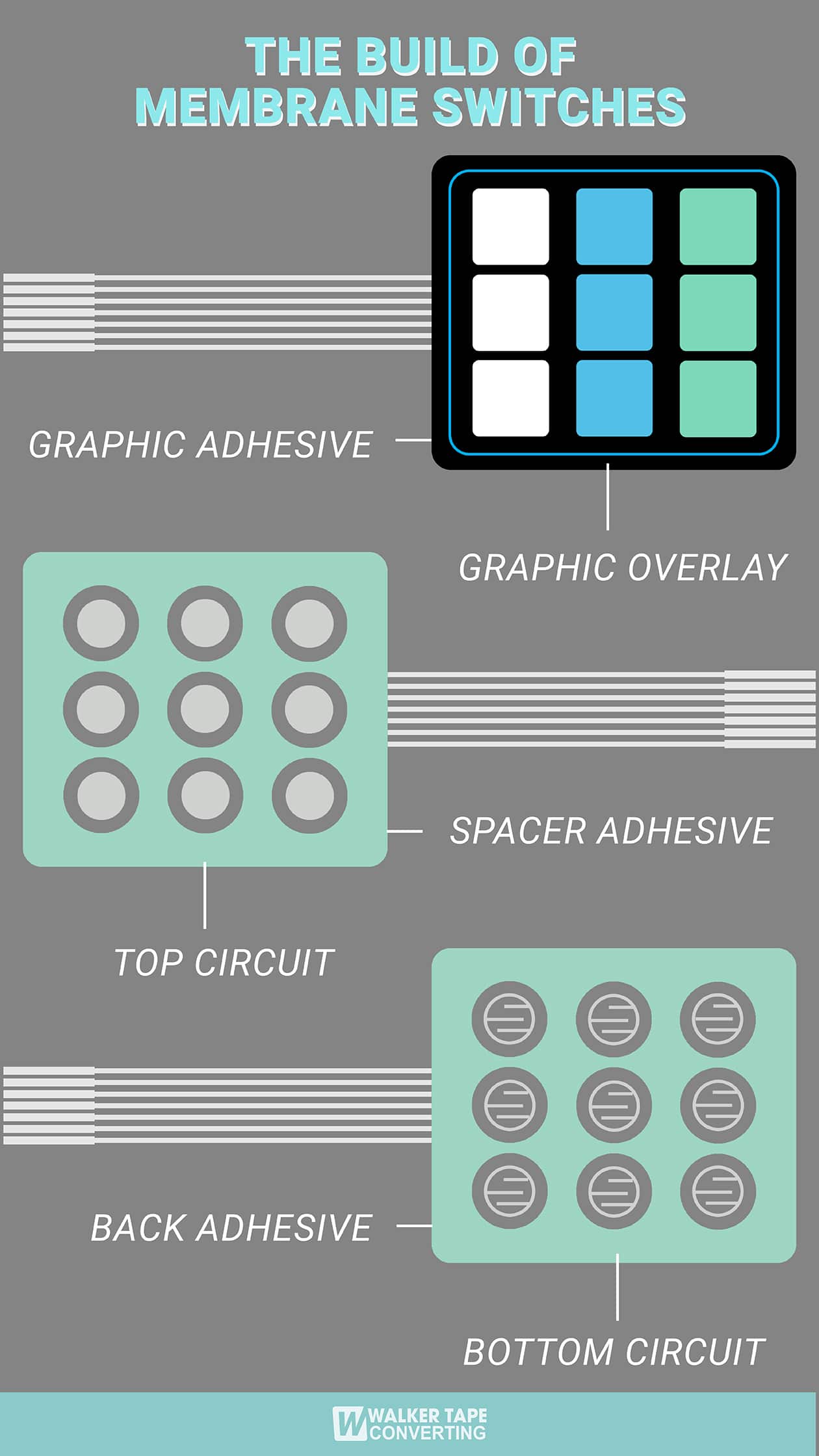Tailored Designs by a Professional Membrane Switch Manufacturer
Recognizing the Significance of Membrane Switch in Modern Electronic Devices and Their Applications
Membrane switches over offer as an essential element in modern electronic devices, providing an efficient user interface for customer communication. Their adjustable and light-weight nature makes them suitable for a series of applications across varied sectors. Recognizing their key parts and advantages can provide insights right into their expanding significance. As technology proceeds to breakthrough, the advancement of Membrane changes questions concerning their future applications and layout innovations. What exists in advance in this vibrant field?

What Are Membrane Buttons?
Membrane switches are vital parts in contemporary electronic devices, functioning as individual interfaces that promote interaction between customers and devices. These buttons include several layers, consisting of a visuals overlay, a sticky layer, and a circuit layer, every one of which collaborate to create a resilient and useful interface. The layout permits a level, low-profile solution that can be customized pertaining to dimension, form, and aesthetic appearance, making them suitable for numerous applications, from consumer electronic devices to medical gadgets. The tactile responses offered by Membrane switches improves individual experience, while their resistance to dirt and dampness makes them optimal for challenging atmospheres. Furthermore, Membrane switches can incorporate functions such as backlighting and printed graphics, further expanding their usability. Their flexibility and effectiveness make them a recommended option in industries where reliability and simplicity of usage are vital, inevitably adding to the smooth operation of modern-day electronic gadgets.
Secret Elements of Membrane Switches
While numerous components add to the performance of a membrane layer switch, three key layers play significant duties in its design and operation. The top layer, typically made from a resilient polymer, offers as the user interface for customer interaction, typically featuring printed graphics and icons. Underneath this is the spacer layer, which maintains the required range in between the top layer and the circuit layer. This spacer layer guarantees that the button turns on just when pressed, stopping accidental inputs. The circuit layer consists of conductive traces that complete the electric circuit when the leading layer is dispirited. These traces can be made from numerous materials, consisting of copper or silver. With each other, these components develop a durable and reliable gadget that is small and versatile, ideal for a vast variety of digital applications, from house home appliances to medical gadgets. Understanding these essential elements is essential for valuing the general functionality of Membrane switches.
Advantages of Using Membrane Switches Over

Membrane Switch Production Process
Understanding the Membrane switch manufacturing procedure exposes the detailed steps associated with generating these vital parts. The process commonly begins with the layout stage, where layouts and requirements are developed utilizing specialized software program. Following this, the graphic overlay is published on a flexible substratum, usually utilizing high-resolution printing methods to assure clearness and precision.Next, the sticky layers are applied, which serve to bond the numerous parts with each other. The circuit layers, made from conductive inks or products, are after that printed onto a separate substratum. These layers are very carefully straightened and laminated flooring to produce a useful switch.After setting up, the buttons undergo examining to confirm capability and toughness. Quality control measures are applied throughout the process to identify and remedy any kind of defects. The completed Membrane buttons are packaged and prepared for distribution, all set to satisfy the needs of modern electronic applications.
Applications of Membrane Switches Over in Different Industries
Membrane buttons are increasingly utilized throughout various industries, specifically in medical devices and customer electronic devices. In the clinical field, they provide trustworthy control interfaces for gadgets that call for exact procedure. In customer electronic devices, these switches improve user interaction by using receptive and sleek user interfaces. Receptive Medical Devices Control
Many modern clinical gadgets use Membrane buttons for structured operation and boosted individual interaction. These switches give a reputable, sturdy interface for a selection of applications, including analysis equipment, person tracking systems, and medical tools. Their adjustable designs permit certain designs that can suit the distinct demands of healthcare specialists, guaranteeing user-friendly navigation and reliable accessibility to vital functions. Additionally, Membrane switches are immune to impurities, making them suitable for clean and sterile environments. The responsive comments they offer can boost customer self-confidence, decreasing the danger of mistakes during important clinical procedures. In general, the assimilation of Membrane switches in clinical tools considerably adds to boosted functional effectiveness and individual security in healthcare settings.
Consumer Electronics Interfaces
In the domain name of consumer electronics, Membrane switches play a critical role in enhancing interface across a vast array of tools. These switches are indispensable to products such as remote controls, microwaves, and pc gaming consoles, giving a user-friendly and reliable interface. Their style enables a smooth integration of graphics and functionality, enabling makers to produce smooth, modern-day aesthetic appeals without compromising usability. Membrane buttons are also known for their toughness, commonly withstanding considerable use and direct exposure to different ecological problems. In addition, they can incorporate attributes like backlighting and tactile comments, more boosting the customer experience. As consumer needs for advanced yet intuitive user interfaces grow, Membrane switches over remain to be an important element in advancing electronic device performance.
Design Factors To Consider for Membrane Switches Over
Designing reliable Membrane switches over requires mindful focus to different elements that affect both performance and individual experience. One crucial consideration is the selection of products, as they can influence sturdiness, tactile comments, and visual allure. Selecting an ideal adhesive is necessary for assuring long-lasting attachment and resistance to ecological factors.In enhancement, the format and layout of the button need to suit individual interaction, with button sizes and spacing optimized for simplicity of use. The unification check my source of graphics and labeling ought to prioritize quality and exposure under numerous lighting conditions.Consideration of electrical features, such as actuation force and button sensitivity, will boost the responsiveness of the Membrane switch. In addition, the style must suit producing processes to guarantee cost-effectiveness and timely production. In general, a well-balanced style boosts both the functionality and the user experience of Membrane switches in contemporary electronics.

Future Trends in Membrane Switch Technology
As innovation continues to develop, Membrane buttons are poised to integrate new advancements that will boost their functionality and application in different fields. One considerable trend is the unification of adaptable and resilient products, which will certainly enhance the lifespan and dependability of these buttons. Improved surface appearances and adjustable graphics are likewise anticipated, enabling more intuitive individual interfaces.Moreover, the integration of clever technology, such as touch-sensitive surface areas and haptic feedback, is expected to boost customer communication, making Membrane changes much more engaging and responsive. Additionally, advancements in printed electronic devices will certainly make it possible for more complex wiring within thinner accounts, better increasing style possibilities.Sustainability will certainly also play an essential role in future advancements, as manufacturers check out environmentally friendly materials and manufacturing processes. In general, these fads will certainly guarantee that Membrane changes remain relevant and vital in an interconnected and progressively digital world.
Regularly Asked Questions
How Do Membrane Changes Contrast to Standard Mechanical Buttons?
Membrane switches over deal benefits over standard mechanical switches, including lowered size, lighter weight, and boosted toughness. They typically supply a sealed surface area, enhancing resistance to dust and dampness, making them ideal for varied applications.
What Materials Are Generally Used in Membrane Switch Construction?

Can Membrane Changes Withstand Extreme Environmental Issues?
Membrane switches can stand up to severe environmental problems, depending on their style and materials. Premium building and constructions frequently feature resilience against temperature level changes, moisture, and exposure to chemicals, making them ideal for different requiring applications across sectors.
Exactly How Long Do Membrane Switches Over Commonly Last Before Failing?
Membrane switches typically exhibit a life-span varying from 1 to 10 million actuations, depending upon elements such as use frequency, environmental conditions, and producing quality. Normal upkeep can expand their toughness and operational integrity significantly.
Are Membrane Changes Personalized for Certain Applications?
Membrane switches are without a doubt adjustable for specific applications. They can be customized in design, performance, and dimension, allowing manufacturers to satisfy special user requirements and improve product visual appeals while keeping functional effectiveness and resilience. Membrane switches are essential parts in modern-day electronic devices, offering as individual interfaces that help with interaction in between individuals and gadgets. The tactile comments supplied by Membrane changes enhances user experience, while their resistance to dust and dampness makes them ideal for challenging environments. The official site unification of graphics and labeling ought to prioritize clarity and visibility under different lighting conditions.Consideration of electrical features, such as Full Report actuation force and button level of sensitivity, will certainly improve the responsiveness of the Membrane button. Boosted surface area appearances and customizable graphics are also prepared for, permitting for even more instinctive customer interfaces.Moreover, the assimilation of clever technology, such as touch-sensitive surface areas and haptic comments, is expected to boost customer interaction, making Membrane switches over extra appealing and receptive. Membrane switches over deal benefits over traditional mechanical switches, including reduced dimension, lighter weight, and boosted durability.